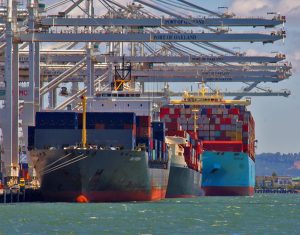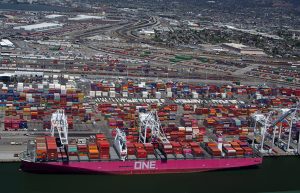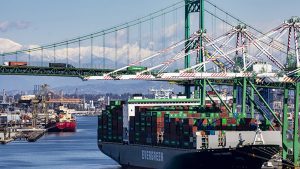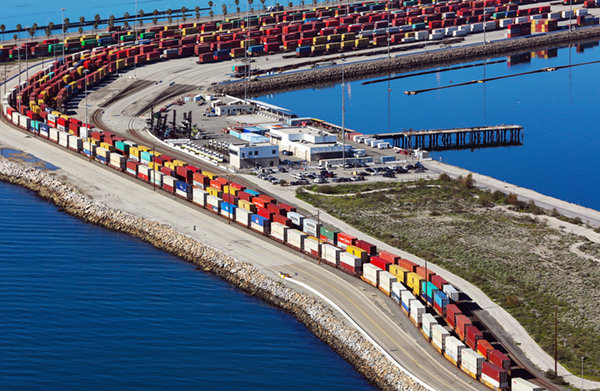
It’s no secret that the West Coast freight surge is building toward an even more feverish pace this fall. And why freight surged is also no secret to anyone who pays attention: the consumer-driven U.S. economy was supercharged after COVID-19’s effects waned.
Why congestion resulted is no secret either: not enough equipment and people and space for cargo, along with too many mismatches in efficient handoffs of freight pickups and deliveries. Major carriers’ decisions to temporarily restrict shipment flow for hours or days to balance their own freight networks were a factor, too.
Those inside the industry recognize both some impressive statistics that demonstrate how much freight is being moved and the raft of disturbing and dismaying evidence to illustrate congestion’s scope.
On the positive side, a record 19 million TEU or more are expected to pass through San Pedro Bay ports, according to Port of Long Beach Executive Director Mario Cordero. That would be about a 10% year-to-year increase, resulting from month after month of cargo topping the prior year period. Other West Coast ports are posting solid volume growth, as well.
A Consistent Message
From all corners of the industry, the hectic pace message is consistent.
Port of Oakland Maritime Director Bryan Brandes offered a situational explanation of congestion, citing “the big upswing in import volumes, port closures around the world due to pandemic and weather-related shutdowns, labor shortages, and vessel schedule disruptions.”
Others were more succinct in describing conditions.
“Everyone is pushing at top speed,” was Port of Los Angeles Executive Director Gene Seroka’s assessment as warehouses and rail yards overflow, and chassis are “hard to come by.”
Cordero deployed basketball’s “full court press” analogy, emphasizing that all parts of the supply chain are doing their part to deliver.
Dan Smith, a principal at consultant Tioga Group, used the familiar saying that “you don’t build the church for Easter Sunday” to dramatize 12 consecutive months of strong freight volume that has overtaxed industrywide cargo capacity.
“Challenges are not being felt by one mode alone, in the tangled web that is the global supply chain, If you pull on one string, everything shakes,” said Matt Schrap, CEO of the Harbor Trucking Association. “If you think congestion is bad now, just wait until we get into the heart of peak shipping season.”
He also made an important, additional point.
“The blame game doesn’t move cargo any faster,” he remarked. “We are all in this together.”

of Oakland.
Illustrating the Situation
Just how bad is the congestion? A few statistics, and the accompanying charts, illustrate the situation.
Dwell time for containers leaving San Pedro Bay ports by truck was 5.2 days, or 88% higher in July than the same month in 2020, according to the Pacific Merchant Shipping Association. That number was dwarfed by moving cargo off dock by rail, which reached 13 days, according to the Port of Los Angeles.
On a webinar last month, industry expert Larry Gross of Gross Transportation Consulting said strong demand and capacity constraints have limited rail intermodal growth and boosted demand for drayage to record levels.
Street cycle time for chassis measured by Southern California’s equipment pool operator, doubled in the summer of 2021, resulting in a 50% drop in productivity, Smith added.
At sea, dozens of container ships were waiting to unload fall peak cargo, according to the Southern California Marine Exchange. Meanwhile, Oakland’s port completely eliminated vessels waiting in early September, though a vessel backup was expected in the fall and winter.
There were some other bright spots, besides the volume increases. Oakland officials said terminal operators and longshore workers were moving 66% more cargo per vessel this year compared to 2020.
Union Pacific Railroad CEO Lance Fritz told the Surface Transportation Board that truck dwell times inside the railroad’s terminals had been “relatively consistent” this year compared to the past.
BNSF Railway Group Vice President Tom Williams noted that the railroad has for more than a year moved 110,000 boxes a week during non-holiday periods, its highest sustained volume ever.
Interdependence
Melanie Stambaugh, senior manager of communications at the Northwest Seaport Alliance, as well as Williams, Fritz and others also underscored the interdependence of freight moving businesses.
She said strong import demand “has led to frequent vessel schedule changes, making planning shipments difficult. Equipment shortages and rail and warehouse congestion are requiring containers to remain on terminals longer than normal. Terminal congestion reduces the working space of our labor partners, making it more difficult to work vessels efficiently.”
Fritz remarked that all stakeholders must maintain a consistent flow of freight.
“We capture and execute a finite portion of the transportation pipeline,” he said. “Critical to clearing the congestion and keeping the network fluid will be vital non-railroad improvements to the inadequate takeaway capacity at our ramps.”
Williams said intermodal freight is a collaborative effort by definition.
“We continue to engage on a number of targeted efforts with our core ocean carriers, beneficial cargo owners and the local dray community to work together on this challenging supply chain issue,” he said, emphasizing a point others also made to Pacific Maritime.
All the focus on the West Coast situation overlooks two other important facts, multiple officials said.
One is that congestion is occurring all over North America, and worldwide. The other is that levels of congestion continue to be influenced by steps such as manufacturers’ production shifts from China to Southeast Asia, which results in more U.S.-bound vessels transiting the Suez Canal rather than the Transpacific route.

‘Survive the Next Hour’
“People are all trying to survive the next hour,” said Smith. “They’re too busy to think about the future.”
When will this surge slow down? Not anytime soon is a clear message. Sometime next year was a general expectation by those interviewed, but predictions also were nuanced.
“There is no end in sight until Lunar New Year (in early February),” said Jessica Alvarenga, government affairs manager for the Pacific Merchant Shipping Association. At the same time, she said that the surge resulting from the pandemic and the economic rebound will end eventually.
“Congestion isn’t here to stay,” she said, tying the origin of the current situation to the coronavirus pandemic and resulting port dislocations in Asia.
“Many have suggested Q2 of 2022, at the earliest,” Schrap said.
“We are going to continue to have high volume until the end of the year. Maybe in the spring of 2022 we will see some sense of normalcy,” Cordero remarked.
“We may not see the dramatic increase again that spawned this year’s cargo surge, but we think there will be continued growth at more modest levels moving forward,” stated Brandes.
Smith provided a longer-term perspective, saying that volume needs to be closely scrutinized early next year.
“If we could somehow handle everything people wanted us to move now, we would have massively underutilized freight capacity for the last five or more years. If volumes fall back early next year to 2018 and 2019 levels, everyone gets to breathe out. If not, there has to be a massive building spree.”
A building spree raises more questions: where, who pays, and government’s role, given the cost of infrastructure and shortage of available land near ports. An instructive lesson could come from BNSF’s Southern California intermodal terminal project, first announced in 2003, whose construction still hasn’t been approved.
What’s Being Done
Broadly speaking, storage space, mostly off-dock, has been added at ports up and down the West Coast. Gate hours at ports have been extended to create more capacity. BCOs and manufacturers altered their operations, and sourcing.
More specifically, Union Pacific added parking spaces at two Chicago area terminals and capped demurrage fees for ocean carriers if containers were in a rail terminal stack.
Four new cranes with additional capacity are in use, or soon will be, by terminal operators at Oakland. Also in Oakland, hundreds of new casual workers who are members of the International Longshore and Warehouse Union were hired and trained during the summer.
BNSF Railway boosted lift equipment by 20% at key facilities, increased hiring at terminals by as much as 35%, according to Williams. Additional container storage and unloading capacity were added at a Chicago facility to offload trains that couldn’t be worked because chassis weren’t available. A terminal in the Memphis, Tenn. region also was reopened.
Cordero said dual transactions at some Long Beach terminals have reached 50%, and have been as high as 70%. Long Beach customers receive weekly advance information on vessel arrivals. Regular meetings with stakeholders also are convened, he added.
“Earlier this year, the Northwest Seaport Alliance created the Gateway Performance Taskforce to identify opportunities to alleviate congestion challenges in our gateway,” Stambaugh said. “Working closely with our marine terminal operators, ocean carriers, rail and trucking partners, and labor partners, we are continuing to identify ways to reduce the congestion.”
Technology is being enhanced, such as Los Angeles’ Port Optimizer tool developed in conjunction with Wabtec to provide more inbound vessel information to all stakeholders, Seroka said.

Much More to Do
What more can be done to cut delays? There seem to be as many ideas to reduce congestion as steps to combat it. And the multitude of answers aren’t easy either.
Seroka offered a broad perspective.
“We have to coordinate better,” he said on an August media conference call, pinpointing a widespread industry goal.
Smith explained the consequences of what happens when coordination doesn’t work as planned, a burden that often falls on truckers.
Appointment systems, while they are an advancement, still need to be further refined to add flexibility, Smith said. There can be too much rigidity in those times, leaving no space to adjust for traffic delays, or other factors, like a driver feeling sick.
If an appointment is missed or a BCO’s destination facility can’t accept the freight, the trucker has to “sit” on that box, sometimes for days, tying up a chassis as well.
At ports, the picture is complicated by more than appointments.
Truckers’ time spent in terminals has increased in Southern California by 26% to 78 minutes compared with July of last year, according to the Harbor Trucking Association (see graphic). However in Oakland, it dropped to 85 minutes in July from 97 minutes on a year-over-year basis. Importantly, California terminal times vary widely, ranging from 25 minutes to 137 minutes.
Terminal times don’t tell the whole story, as drivers too often have to make a separate move to drop off an empty or go to a staging yard off the port, Smith explained.
“These are bottlenecks that don’t need to happen,” Smith maintained, because ocean carriers restrict empty returns to avoid extra charges at port terminals.
Better coordination should pay significant benefits, too, in terms of productivity. Truckers who have experienced a drop in daily trips in the past year from three to two because of delays and congestion will avoid that 33% drop in productivity once they gain back that third trip.
Truckers’ Rush Hour
Alvarenga noted that there is room for improvement for trucking operations as well.
“It would be helpful if more gate hours were utilized across the board, not just in rush hours. That would help gets containers off terminals and create space for more. That would enable vessels at anchor to go to berth,” she said. “Our terminal operators need the space to continue getting containers in and out of the terminals quickly and smoothly.”
She noted that the 88% increase in Southern California container dwell time on terminals is rising faster than truckers’ time spent in them because of congestion that has made it more difficult to unload vessels.
Oakland is building a Freight Intelligent Transportation System (FITS), Brandes said, part of broader effort to upgrade roadway infrastructure. The FITS project includes communications technology upgrades and a traffic management center.
Cordero advocated an industry-wide goal.
“For me, the vision is a 24/7 operation. There are people who are skeptics about that vision (but) what is the cost of doing nothing? Enormous. We need to move to a new model.”
“Whether the next step (for port operations) is 16 (hours)/5 (days a week) or 16/6, the movement toward 24/7 is a vision that has to come into play,” Cordero remarked. “I’d like to say we will see 24/7 sometime soon.”

